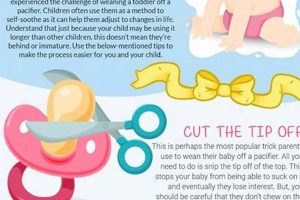Footwear designed for infants and toddlers, incorporating features that extend upwards to provide stability around the ankle joint, is commonly sought by caregivers. These specialized shoes aim to restrict excessive movement and offer enhanced support during the early stages of ambulation and development.
The perceived benefits of this type of footwear include improved balance, reduced risk of ankle sprains, and facilitation of proper foot and ankle development. Historically, such designs have been recommended by some pediatricians and podiatrists, particularly for infants with specific musculoskeletal conditions or those who exhibit instability while learning to walk. However, the necessity and long-term effects are subjects of ongoing debate within the medical community.
The following sections will delve into the construction materials, design variations, potential advantages, possible drawbacks, and expert recommendations concerning infant footwear with elevated ankle bracing, providing a comprehensive overview for informed decision-making.
Guidance on Infant Footwear Selection
The following recommendations are provided to assist in making informed decisions regarding footwear selection for infants, focusing on aspects of stability and support.
Tip 1: Consult with a Pediatrician or Podiatrist: Prior to purchasing specialized footwear, seek professional advice to determine if such features are truly necessary for the infant’s specific needs. A qualified healthcare provider can assess the infant’s foot and ankle development and recommend appropriate options.
Tip 2: Prioritize Proper Fit: Ensure the footwear fits the infant’s foot accurately, with sufficient room for the toes to move freely. Ill-fitting shoes can impede natural foot development and cause discomfort. Regular measurements of the infant’s feet are advised.
Tip 3: Opt for Flexible Soles: While ankle support is a key consideration, the sole of the shoe should remain flexible to allow for natural foot movement and muscle development. Rigid soles can restrict movement and hinder proper gait development.
Tip 4: Choose Breathable Materials: Select footwear constructed from breathable materials such as leather or canvas to minimize moisture build-up and maintain a comfortable environment for the infant’s feet. Excessive moisture can lead to skin irritation and fungal infections.
Tip 5: Monitor for Signs of Discomfort: Regularly inspect the infant’s feet for any signs of redness, blisters, or pressure marks. These indicators may suggest that the footwear is not fitting properly or is causing undue stress on the foot.
Tip 6: Consider Activity Level: The level of support required may vary depending on the infant’s activity level. Infants who are primarily crawling may not require the same level of support as those who are actively walking and exploring.
Tip 7: Inspect Construction Quality: Thoroughly examine the footwear for any defects in construction, such as loose seams or sharp edges. Poorly constructed shoes can pose a safety hazard and may not provide adequate support.
Adhering to these guidelines can contribute to the selection of appropriate infant footwear that promotes healthy foot development and supports stability during early stages of ambulation.
The subsequent sections will address the potential benefits and drawbacks of various footwear styles, further informing the selection process.
1. Stability
The concept of stability is paramount when considering footwear intended for infants, particularly designs incorporating elevated ankle support. This attribute directly influences the infant’s ability to maintain balance and coordinate movement during the critical early stages of motor skill development.
- Biomechanical Influence
The presence of extended ankle support modifies the biomechanics of the lower limb, potentially restricting excessive pronation or supination. This restraint aims to stabilize the ankle joint, particularly in infants who may exhibit ligamentous laxity or poor proprioception. Examples include minimizing inward rolling of the ankle during weight-bearing. The implication is a potentially reduced risk of ankle sprains and improved postural control.
- Impact on Gait Development
The type of footwear can affect the natural gait cycle. Excessive external stabilization could, theoretically, hinder the development of intrinsic foot and ankle musculature. For example, rigidly supported footwear could limit the range of motion required for a normal heel-to-toe gait pattern. The potential implication is a reliance on external support, possibly impeding the strengthening of muscles that contribute to natural stability.
- Surface Interaction
The outsole of the footwear significantly contributes to stability by influencing traction and ground contact. Non-slip outsoles, constructed from materials such as rubber, enhance stability by preventing slippage on various surfaces. For example, a textured outsole can provide a firmer grip on smooth flooring. The implication is improved confidence and reduced risk of falls during ambulation, particularly on unpredictable surfaces.
- Proprioceptive Feedback
While external support aims to enhance stability, it can also potentially reduce the sensory feedback received from the foot and ankle. This feedback, known as proprioception, is crucial for maintaining balance and coordinating movement. For instance, constant external stabilization may decrease the foot’s ability to sense subtle changes in terrain. The implication is a possible dependence on external support and a decreased reliance on the body’s natural balance mechanisms.
The interplay between these facets highlights the complex relationship between footwear, stability, and infant development. The selection of footwear that effectively balances external support with the promotion of natural foot and ankle function is crucial for fostering optimal motor skill development and minimizing potential long-term consequences.
2. Development
The influence of footwear on infant development is a subject of ongoing research and debate. The specific design of footwear, especially considerations like ankle support, can potentially affect musculoskeletal development, gait patterns, and the acquisition of balance and coordination. Footwear that restricts natural foot movement may impede the development of intrinsic foot muscles, while overly supportive designs might limit sensory feedback necessary for postural control. Conversely, footwear lacking adequate support may increase the risk of instability or injury during early ambulation. Understanding these potential effects is crucial for making informed decisions regarding infant footwear choices.
For example, consider two contrasting scenarios. An infant consistently wearing rigid, high-ankle boots might experience restricted ankle mobility, potentially affecting the development of ankle joint flexibility and strength. This could manifest as altered gait patterns later in life. In contrast, an infant consistently wearing extremely minimalist footwear with no ankle support might be at an increased risk of ankle sprains or instability, especially on uneven surfaces. These examples highlight the importance of striking a balance between protection and the promotion of natural foot function.
Ultimately, the connection between footwear and development underscores the need for careful consideration and, ideally, professional consultation. While there is no universal consensus on the optimal type of footwear for all infants, understanding the potential impact of different designs on foot development, gait, and balance is paramount. Healthcare providers, such as pediatricians and podiatrists, can provide personalized recommendations based on individual needs and developmental milestones. The careful selection of footwear contributes to healthy musculoskeletal development and facilitates the acquisition of age-appropriate motor skills.
3. Materials
The selection of materials in footwear designed for infants, especially those incorporating ankle support features, plays a crucial role in determining comfort, durability, safety, and overall impact on foot development. Material properties influence breathability, flexibility, weight, and the potential for allergic reactions. Therefore, careful consideration of material composition is essential when evaluating such products.
- Leather
Leather, a traditional material for footwear, offers a balance of durability and breathability. It conforms to the foot over time, providing a degree of personalized fit. However, leather can be relatively heavy and may require a break-in period. In infant footwear, particularly those with ankle support, leather can provide the necessary structure and support while still allowing for some flexibility. Concerns regarding sourcing and tanning processes should be considered. For example, vegetable-tanned leather minimizes the risk of exposure to harmful chemicals.
- Textiles (Canvas, Mesh)
Textile materials, such as canvas and mesh, offer enhanced breathability and reduced weight compared to leather. These materials are often used in the lining or upper portions of infant footwear, especially in warmer climates. However, textiles may offer less structural support than leather and may be more prone to wear and tear. For infant footwear with ankle support, textiles may be combined with other materials to provide a balance of comfort and stability. For instance, canvas uppers may be paired with a reinforced leather or synthetic heel counter for added ankle support.
- Synthetics (PU Leather, Microfiber)
Synthetic materials, including PU leather and microfiber, offer durability, water resistance, and often lower cost compared to natural leather. These materials can be engineered to mimic the look and feel of leather while offering specific performance characteristics. However, synthetics may be less breathable than natural materials and may contribute to increased foot perspiration. In footwear with ankle support, synthetics may be used in areas requiring durability or water resistance, such as the outsole or heel counter. For example, a PU leather upper may be paired with a breathable mesh lining to mitigate the lack of breathability.
- Outsole Materials (Rubber, Thermoplastic Polyurethane – TPU)
The outsole material significantly influences traction, durability, and flexibility. Rubber outsoles provide excellent grip on various surfaces, while TPU offers a balance of durability and flexibility. The outsole design is particularly important in infant footwear with ankle support, as it contributes to overall stability and balance. For instance, a non-slip rubber outsole with a wide footprint can enhance stability during early ambulation. The selection of appropriate outsole materials also impacts the weight and overall comfort of the footwear.
The interplay of these materials in infant footwear with ankle support necessitates a holistic evaluation. The ideal combination balances breathability, support, durability, and safety, while considering the infant’s individual needs and activity level. Prioritizing materials that minimize the risk of allergic reactions and promote a healthy foot environment is crucial. Ultimately, a well-chosen combination of materials contributes to the functionality and appropriateness of infant footwear designs.
4. Fit
The relevance of proper fit in infant footwear, particularly designs incorporating ankle support, cannot be overstated. The intended benefits of enhanced stability and support are contingent upon accurate sizing and appropriate accommodation of the infant’s foot. Ill-fitting footwear, irrespective of the presence of ankle support features, can lead to adverse consequences, potentially negating any intended advantages. A primary effect of inadequate fit is the introduction of pressure points, which can impede circulation, cause discomfort, and contribute to skin irritation or blistering. Furthermore, shoes that are too small restrict natural foot movement, hindering proper development, while excessively large shoes compromise stability and increase the risk of trips and falls. Therefore, precise fit constitutes a fundamental prerequisite for realizing the intended benefits of infant footwear with ankle support.
Practical application of this understanding necessitates meticulous attention to detail during the selection process. Measurement of the infant’s foot, using appropriate sizing tools, is an essential first step. Footwear should be selected based on these measurements, considering both length and width. A static assessment is insufficient; a dynamic evaluation, observing the infant’s gait while wearing the shoes, is recommended. This evaluation should focus on identifying any signs of discomfort, instability, or gait abnormalities. Examples include observing toe crowding, heel slippage, or altered walking patterns. Adjustments to lacing or closure mechanisms may be necessary to achieve a secure and comfortable fit without undue constriction. Periodic reassessment of fit is also crucial, as infants’ feet grow rapidly, necessitating frequent adjustments in footwear size.
In summary, proper fit is not merely a desirable attribute but a critical component of infant footwear with ankle support. Failure to prioritize accurate sizing and appropriate accommodation of the infant’s foot undermines the intended benefits of stability and support, potentially leading to adverse consequences. Ongoing monitoring and adjustments are essential to ensure that the footwear continues to provide adequate support without impeding natural foot development. Overcoming the challenge of obtaining accurate measurements and consistently reassessing fit requires diligence and awareness, ultimately contributing to the health and well-being of the infant’s developing feet.
5. Flexibility
The attribute of flexibility, when considered in the context of infant footwear designs incorporating ankle support, presents a complex interplay of biomechanical factors. The degree to which footwear permits or restricts natural foot motion directly influences musculoskeletal development, gait patterns, and overall comfort. Therefore, the consideration of flexibility is paramount in evaluating the suitability of such footwear for infants.
- Sole Flexibility and Gait Development
The flexibility of the shoe’s sole significantly impacts the infant’s gait cycle. A highly rigid sole may impede the natural rolling motion of the foot during walking, potentially hindering the development of intrinsic foot muscles and altering gait patterns. Conversely, an overly flexible sole may offer insufficient support, compromising stability. The ideal balance promotes natural foot movement while providing adequate support. For example, footwear with a sole that bends easily at the metatarsal joints allows for a more natural stride, encouraging proper muscle activation.
- Ankle Support Material Flexibility
The material composition of the ankle support component directly affects its flexibility and the degree of restriction imposed on ankle movement. Rigid materials provide maximum support but may limit the range of motion, potentially hindering ankle joint development. More flexible materials offer less support but allow for a greater range of motion, facilitating the strengthening of ankle muscles. The appropriate choice depends on the individual needs of the infant, considering factors such as ligamentous laxity or developmental delays. As an example, a semi-rigid ankle support made from flexible polymers may offer a compromise between stability and mobility.
- Impact on Proprioception
Footwear flexibility influences the sensory feedback received from the foot and ankle, known as proprioception. This feedback is crucial for maintaining balance and coordinating movement. Highly restrictive footwear may diminish proprioceptive input, potentially leading to a reliance on external support and hindering the development of intrinsic balance mechanisms. Footwear that allows for greater foot movement enhances proprioceptive awareness, promoting the development of natural balance skills. For instance, footwear that allows the infant to feel the texture of the ground encourages active engagement of foot muscles and enhances proprioceptive feedback.
- Flexibility and Comfort
The degree of flexibility directly impacts the overall comfort of the footwear. Rigid footwear may cause discomfort and restrict natural foot movement, leading to fatigue and potential skin irritation. More flexible footwear conforms to the foot’s shape and allows for greater freedom of movement, enhancing comfort. Comfort is a crucial factor in ensuring that the infant is willing to wear the footwear, facilitating compliance with any therapeutic recommendations. As an example, footwear made from soft, flexible materials that conform to the shape of the foot minimizes pressure points and enhances overall comfort.
The selection of infant footwear designs incorporating ankle support requires a careful consideration of the balance between stability and flexibility. The specific needs of the infant, including developmental stage, musculoskeletal conditions, and activity level, should guide the choice of footwear that promotes optimal foot health and motor skill development. Prioritizing flexibility, while maintaining adequate support, contributes to natural movement patterns and long-term musculoskeletal well-being.
6. Safety
Safety, in the context of infant footwear incorporating ankle support, encompasses multiple facets directly related to the well-being of the child. The primary concern is mitigating the risk of injury during ambulation and activity. Properly designed and fitted footwear can reduce the likelihood of falls and ankle sprains, particularly in infants with pre-existing instability or those learning to walk on uneven surfaces. For example, a shoe with a wide, stable base and a secure ankle closure can provide enhanced support, minimizing the chance of the ankle rolling inward or outward during movement. The correct size and fit are paramount; shoes that are too large or too small can increase the risk of tripping or developing blisters. The materials used in construction should also be non-toxic and free from small parts that could detach and pose a choking hazard.
Beyond immediate injury prevention, long-term foot health is also a safety consideration. Ill-fitting or poorly designed footwear can impede natural foot development, potentially leading to musculoskeletal problems later in life. Footwear with adequate toe room and a flexible sole allows for natural foot movement and muscle development. Overly restrictive or rigid designs can hinder this process. The presence of ankle support should not compromise these fundamental requirements. For instance, a shoe with high ankle support but a narrow toe box can restrict toe movement and potentially contribute to the development of foot deformities over time. Therefore, safety must be holistically considered, encompassing both immediate injury prevention and long-term foot health.
Ultimately, ensuring safety in infant footwear with ankle support demands a comprehensive approach that integrates appropriate design, material selection, accurate fitting, and ongoing monitoring. The goal is to provide stability and protection without compromising natural foot development or introducing new hazards. Caregivers must prioritize these factors when selecting footwear, consulting with healthcare professionals as needed to ensure optimal safety and promote healthy foot development.
7. Support
The fundamental purpose of infant footwear incorporating elevated ankle structures is to provide support. This support is intended to stabilize the ankle joint, particularly during the early stages of independent ambulation. The intended effect is a reduction in the likelihood of ankle instability, such as excessive pronation or supination, which can potentially contribute to ankle sprains or impede the development of a normal gait pattern. For instance, an infant with ligamentous laxity may benefit from the added stability provided by an external support structure that limits excessive ankle movement. The importance of this supportive function is underscored by the fact that infants are still developing their proprioceptive abilities, making them more susceptible to balance disturbances. Therefore, the support component of these shoes is crucial for promoting confidence and facilitating the acquisition of independent walking skills. The practical significance of this understanding lies in the ability to select footwear that appropriately addresses the specific support needs of the infant, potentially mitigating the risk of injury and fostering proper musculoskeletal development.
However, it is critical to recognize that the provision of support is not without potential drawbacks. Excessive or improperly applied support can hinder the development of intrinsic foot and ankle musculature. For example, consistently wearing footwear that rigidly restricts ankle movement may prevent the strengthening of the muscles responsible for natural ankle stability. This, in turn, could lead to a dependence on external support and a decreased ability to maintain balance without it. Therefore, the type and degree of support should be carefully considered in relation to the infant’s individual needs and developmental stage. The assessment of a healthcare professional, such as a pediatrician or podiatrist, can be invaluable in determining the appropriate level of support necessary to promote stability without impeding natural development. Real-world applications include tailored recommendations for infants with specific musculoskeletal conditions, such as clubfoot or flatfoot, where the support requirements may differ significantly. Understanding the nuances of support enables informed decision-making, minimizing potential negative consequences and maximizing the benefits of stability enhancement.
In conclusion, the connection between support and infant footwear with ankle structures is characterized by a delicate balance. The provision of adequate support is essential for promoting stability and facilitating the acquisition of independent walking skills. However, excessive or inappropriate support can hinder natural development and create a dependence on external stabilization. Challenges arise in accurately assessing the individual support needs of the infant and selecting footwear that appropriately addresses those needs without compromising natural foot function. The practical significance of this understanding lies in the ability to make informed decisions, guided by professional expertise, to optimize foot health and promote healthy motor skill development during infancy. Further research is necessary to fully elucidate the long-term effects of different types of support on musculoskeletal development and to refine the guidelines for infant footwear selection.
Frequently Asked Questions
The following questions and answers address common inquiries and concerns regarding footwear incorporating elevated ankle structures for infants. Information presented is intended for educational purposes and should not substitute professional medical advice.
Question 1: Are specialized shoes with ankle support required for all infants learning to walk?
No. The necessity of such footwear depends on individual factors, including musculoskeletal development, gait patterns, and the presence of any underlying conditions. A qualified healthcare provider should assess the infant’s specific needs before recommending specialized footwear.
Question 2: Can prolonged use of restrictive footwear with ankle support impede natural foot development?
Potentially. Excessive or prolonged use of highly restrictive footwear may hinder the development of intrinsic foot and ankle musculature. A balance between support and the allowance of natural movement is crucial.
Question 3: What are the key considerations when selecting footwear with ankle support?
Essential factors include proper fit (length and width), sole flexibility, breathable materials, and the degree of support provided. Footwear should not be too tight or too loose, and it should allow for natural foot movement within reasonable limits.
Question 4: How often should the fit of infant footwear be assessed?
Given the rapid growth rate of infants’ feet, it is advisable to assess the fit of footwear every four to six weeks. Regular measurements are essential to ensure that the shoes continue to provide adequate support and do not restrict growth.
Question 5: Are there potential drawbacks associated with relying solely on external ankle support?
Yes. Over-reliance on external support may diminish proprioceptive feedback and hinder the development of natural balance mechanisms. The aim should be to promote stability while encouraging the strengthening of intrinsic muscles and sensory awareness.
Question 6: What materials are considered optimal for infant footwear with ankle support?
Breathable materials such as leather, canvas, or specialized synthetics are generally preferred. The outsole should provide adequate traction and durability. Materials should also be non-toxic and free from small parts that could pose a choking hazard.
Key takeaways emphasize the importance of individualized assessment, proper fit, material selection, and ongoing monitoring when considering infant footwear with ankle support. The goal is to provide stability and protection without compromising natural foot development or introducing new hazards.
Subsequent sections will address potential alternative approaches to promoting foot health and stability in infants, including exercises and barefoot stimulation.
shoes with ankle support for babies
The preceding examination has elucidated multifaceted aspects of footwear designed for infants, specifically those incorporating elevated ankle structures. Key points include the significance of proper fit, the delicate balance between support and flexibility, the importance of material selection, and the necessity of individual assessment. Potential benefits, such as enhanced stability and reduced risk of ankle instability, must be weighed against potential drawbacks, including hindered development of intrinsic musculature and decreased proprioceptive feedback. A definitive recommendation applicable to all infants cannot be universally prescribed.
The ongoing debate surrounding the utility of specialized footwear necessitates a cautious and informed approach. Continued research is warranted to further elucidate long-term effects on musculoskeletal development. Caregivers are encouraged to seek professional guidance from qualified healthcare providers to determine the most appropriate course of action for individual circumstances. Prioritizing evidence-based practices and prioritizing the promotion of natural foot development is paramount.







